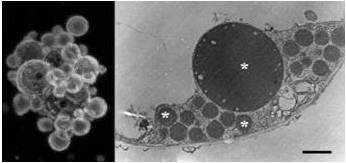Artificial storage organelles for the optimal production of biopharmaceuticals in plants and plant cells
SUPERVISOR: EVA STÖGER
Project assigned to: ANNA HOFBAUER
Background.
Seeds contain natural protein storage organelles and are therefore particularly suitable for the production and storage of recombinant proteins that remain stable and functional in dry seeds for several years at ambient temperatures (Stoger et al., 2000 and 2005; Ramessar et al., 2008). By engineering assembler peptides fused with a protein of interest, artificial ER-derived storage bodies can also be induced in other plant species and organs (Mainieri et al., 2004; de Virgilio et al., 2008; Torrent et al., 2009). In this way the recombinant protein can be obtained in a highly packed and encapsulated manner. The protein encapsulation within protein bodies assures the product does not enter into the degradation pathway and therefore increases productivity. There is good evidence that induced protein bodies can increase the yield of recombinant proteins and afford further desirable properties, such as slow release of a vaccine.

However, the composition of these protein bodies remains to be fully elucidated and the functionality of recombinant proteins derived from these structures must be confirmed prior to the widespread application of this technology. We have started to investigate the protein composition of induced storage bodies, and preliminary data indicate the surprising presence of non-ER-resident proteins. This coincides with areas of different electron-density and unknown content observed within artificial protein bodies.
Aims and methods.
This proposal aims at a more detailed dissection of the content of protein bodies in order to gain a further understanding of protein body formation and to open new and more efficient ways for inducing novel storage compartments for high-value proteins. In addition, a direct comparison of different antigen production strategies (induced protein bodies, virus like particles and starch granule targeting) shall de carried out using antigens with pharmaceutical relevance.
Transgenic lines of Arabidopsis producing induced protein bodies will be readily available at the start of the project. In addition, an initial characterization of the plants will be accessible. To corroborate these preliminary data, protein bodies will be purified using a well established protocol based on density gradient centrifugation. Subsequently, the protein body fraction will be partially digested to distinguish between contents in the periphery and in the core of the protein bodies. In parallel, a detailed characterization of the protein bodies will be carried out using confocal and electron microscopy combined with immunofluorescence and immunogold detection of the recombinant protein. Antibodies against proteins identified within the core of the protein bodies will be obtained to determine their exact localization.
New fusions of the assembler peptides to pharmaceutically relevant antigens such as influenza A virus hemagglutinin or Fuzeon will be constructed and produced in Arabidopsis and tobacco. A comparative study will be carried out using hemagglutinin incorporated within artificial protein bodies, starch granules (via a starch binding domain in maize) and recombinant virus like particles (by co-expression of viral components, taking advantage of previous experience in M. Laimers group). The recombinant protein will be purified and analysed for antigen binding and post-translational modifications. N-glycans will be analysed by LC-ESI-MS as described (Stadlmann et al., 2008).
Bioactivity assays will be designed together with external collaborators to demonstrate and compare antigenicity of proteins enclosed in artificial protein bodies, starch granules or virus like particles.
de Virgilio M, De Marchis F, Bellucci M, Mainieri D, Rossi M, Benvenuto E, Arcioni S, Vitale A (2008). The human immunodeficiency virus antigen Nef forms protein bodies in leaves of transgenic tobacco when fused to zeolin. J Exp Bot. 59:2815-29.
Mainieri D, Rossi M, Archinti M, Bellucci M, De Marchis F, Vavassori S, Pompa A, Arcioni S, Vitale A. (2004) Zeolin. A new recombinant storage protein constructed using maize gamma-zein and bean phaseolin. Plant Physiol. 136:3447-56.
Ramessar K, Rademacher T, Sack M, Stadlmann J, Platis D, Stiegler G, Labrou N, Altmann F, Ma J, Stöger E, Capell T, Christou P. (2008) Cost-effective production of a vaginal protein microbicide to prevent HIV transmission. Proc Natl Acad Sci U S A. 105:3727-32.
Stadlmann, J., Pabst, M., Kolarich, D., Kunert, R., et al. Analysis of immunoglobulin glycosylation by LC-ESI-MS of glycopeptides and oligosaccharides. 2008, Proteomics 8, 2858-2871.
Stoger E, Vaquero C, Torres E, Sack M, Nicholson L, Drossard J, Williams S, Keen D, Perrin Y, Christou P, Fischer R (2000) Cereal crops as viable production and storage systems for pharmaceutical scFv antibodies. Plant Mol Biol 42: 583-590.
Stoger, E, Ma JKC., Fischer R, Christou P (2005) Sowing the seeds of success: pharmaceutical proteins from plants. Curr Opin Biotech 16:167-73.
Torrent M, Llop-Tous I, Ludevid MD (2009). Protein body induction: a new tool to produce and recover recombinant proteins in plants. Methods Mol Biol. 483:193-208.
